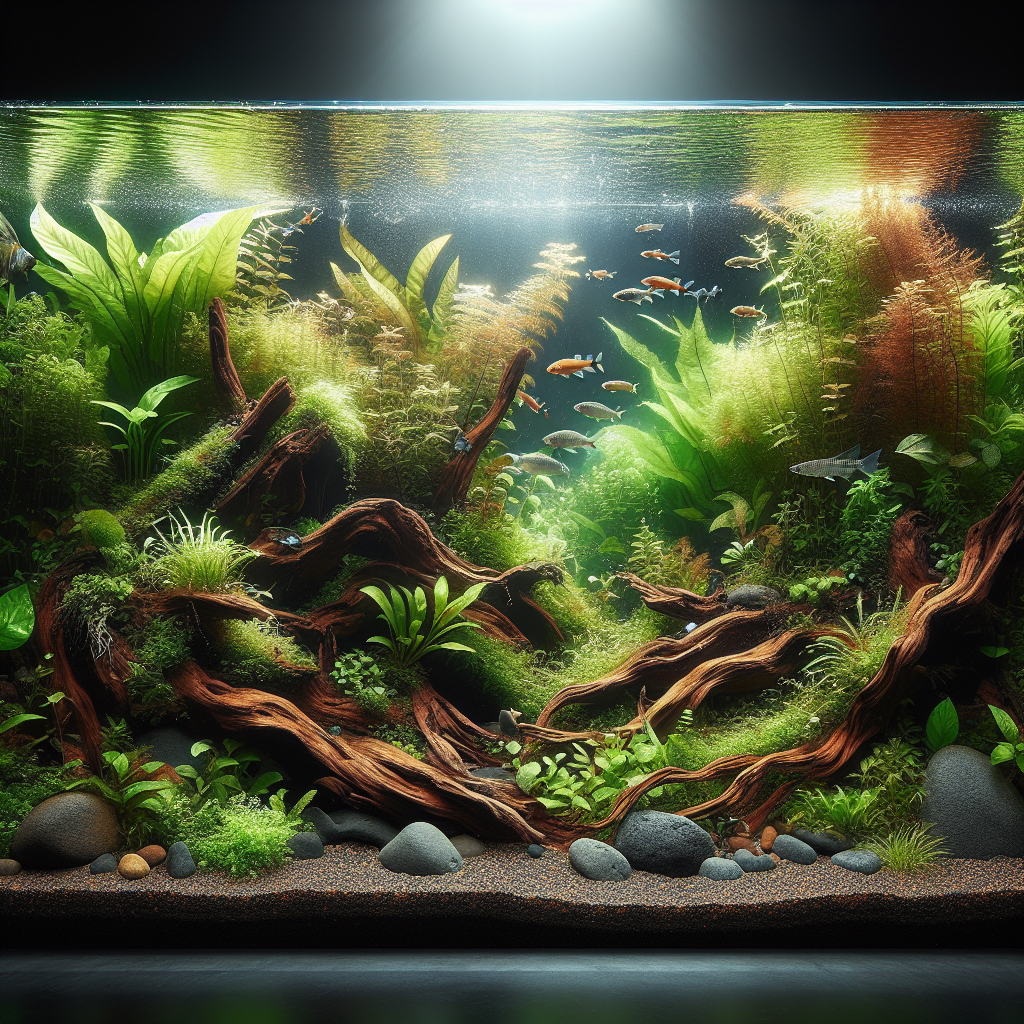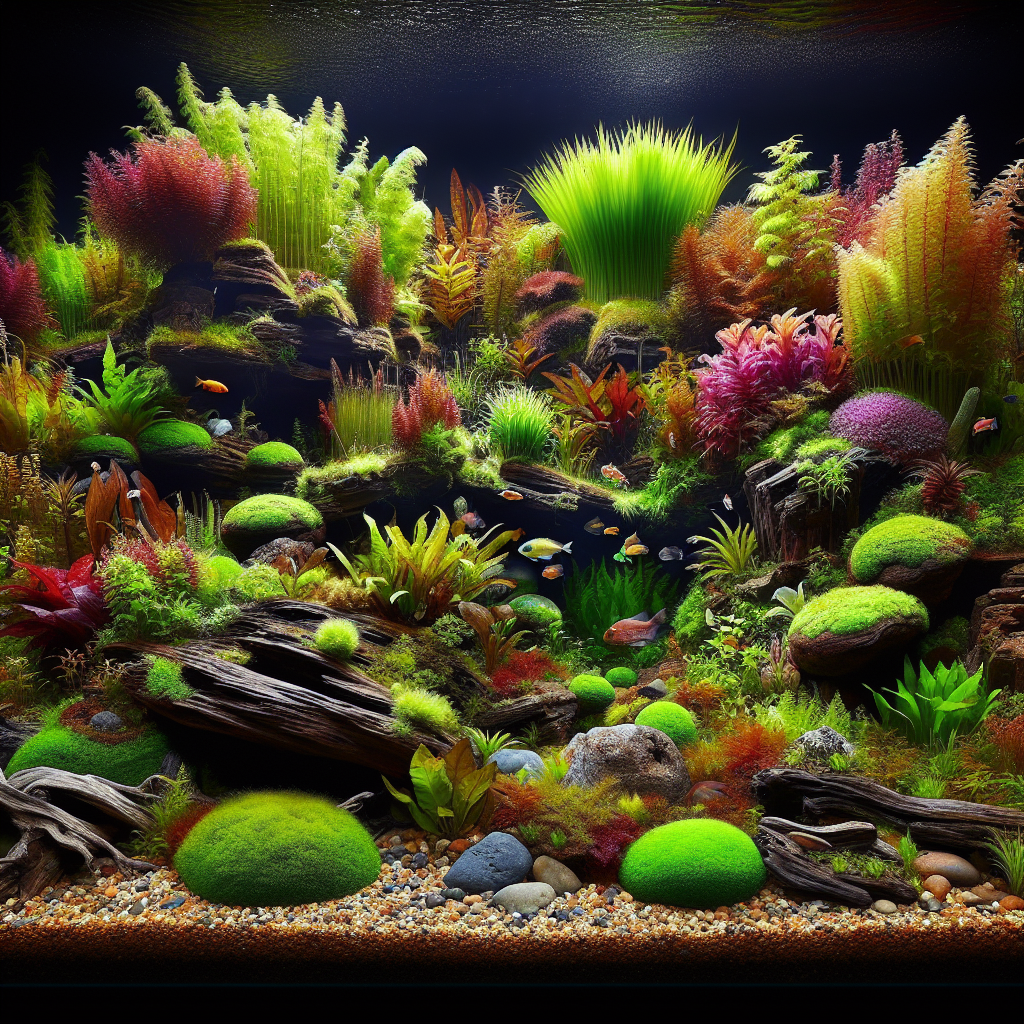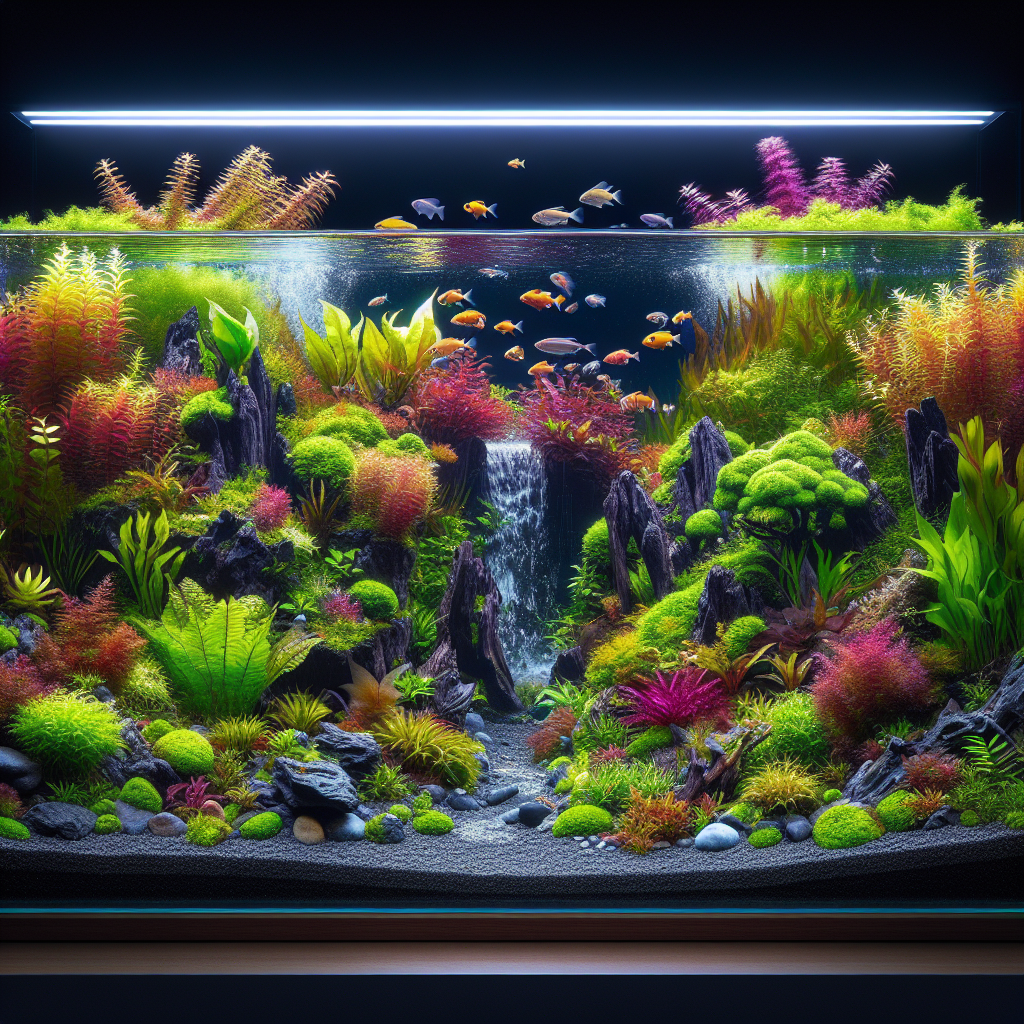A Positive Guide to Transforming Your Aquarium with Plants and Materials
Aquascaping is a captivating blend of art and nature, transforming the confines of an aquarium into a canvas for creativity and ecological harmony. This transformative practice not only enhances the aesthetic appeal of your aquatic environment but also promotes a thriving ecosystem. Whether you’re a seasoned aquarist or a curious beginner, mastering the art of aquascaping can be a fulfilling and enriching experience.
The strategic use of plants and materials lies at the heart of successful aquascaping. By selecting the right combination of aquatic flora and substrates, you can create visually stunning underwater landscapes that mimic natural habitats. The key is to balance the aesthetic elements with the biological needs of your aquatic community, ensuring that both fish and plants coexist in harmony.
Adopting a positive and creative approach allows anyone to learn how to aquascape and transform their aquarium into a dynamic living artwork. From choosing the right aquascaping plants to understanding the properties of different aquascape materials, this guide will provide you with the essential knowledge and inspiration to embark on your aquascaping journey. Dive into this immersive world and discover the myriad possibilities waiting beneath the surface of your aquarium.
Understanding the Basics of Aquascaping

What transforms a simple collection of water and fish into a breathtaking underwater landscape? The answer lies in the intricate dance between aquascaping plants and materials. These elements are not merely decorative; they serve as the backbone of your aquatic ecosystem, impacting everything from water quality to the well-being of your aquatic life. Let’s delve into the foundational aspects that make aquascaping both an art and a science.
Exploring the Importance of Aquascaping Plants
Did you know that the choice of plants in your aquarium can dramatically affect its overall health? Aquatic flora plays a crucial role not only in aesthetic appeal but also in maintaining a balanced environment. These plants act as natural filters, absorbing nitrates and offering oxygenation, which helps sustain the delicate balance necessary for a vibrant aquatic ecosystem.
One of the key benefits of incorporating plants is their ability to mimic natural habitats, providing shelter and breeding grounds for fish. This can reduce stress among your aquatic pets and promote healthier, more active behavior. Moreover, plants like Anubias and Java Fern are not only easy to care for but also enhance the visual depth of your aquascape by adding layers and textures.
- Filtration: Plants absorb excess nutrients and waste, keeping the water clean.
- Oxygenation: Through photosynthesis, they release oxygen, vital for aquatic life.
- Habitat Creation: Offer natural shelter, reducing stress for fish.
Aquascaping isn’t just about placing plants randomly; it involves understanding their specific needs and how they interact with each other. According to Practical Fishkeeping, arranging plants in layers—foreground, midground, and background—can create a sense of depth and dimension, turning your aquarium into a living piece of art.
Selecting the Right Aquascape Materials
Choosing the appropriate materials for your aquascape is akin to selecting the right paints for a canvas. The materials form the foundation upon which your entire aquatic landscape is built, influencing both the aesthetic and functional aspects of your aquarium. From substrates to rocks, each component plays a significant role.
A primary consideration in selecting materials is the substrate, the layer at the bottom of your aquarium. It serves as the growth medium for your plants and contributes to the overall health of the ecosystem. Options like aquatic soil or sand can be chosen based on the plants you’re growing. Aquatic soil, rich in nutrients, is ideal for root-feeding plants, while sand can be a good choice for certain fish species that like to burrow.
When it comes to decorative elements, rocks and driftwood can add a natural touch and create focal points within your aquascape. It’s essential to choose materials that are safe for your aquatic life, avoiding those that could alter water chemistry adversely. The texture and color of rocks can be used strategically to contrast with the lush greens of the plants, enhancing the visual appeal of your aquarium.
- Substrates: Choose between nutrient-rich soils or decorative sands based on plant needs.
- Rocks and Driftwood: Add structure and serve as natural focal points.
- Safety: Ensure materials are non-toxic and won’t alter water chemistry.
As Takashi Amano, a renowned aquascaper, once stated, “An aquarium is not just a container of water; it is a window to nature.” By carefully selecting the right materials and understanding the role of aquascaping plants, you can create an aquatic masterpiece that is both beautiful and ecologically sound.
How to Aquascape: Step-by-Step Guide

Transforming a simple glass box into an enchanting underwater paradise requires meticulous planning. The magic lies in the strategic placement of elements to emulate nature’s beauty. This guide walks you through the essential steps of aquascaping, offering tips and techniques to elevate your aquarium into a masterpiece. From designing your layout to selecting plants and incorporating hardscape elements, each step is crucial in creating a stunning aquatic environment.
Designing Your Aquarium Layout
The layout of your aquarium sets the stage for the entire aquascaping process. Before diving into the details, it’s important to have a clear vision of the scene you wish to create. Will it be a lush jungle, a serene riverbed, or a rocky mountain landscape? Your choice will guide the selection of plants, substrate, and hardscape materials.
Creating Depth and Perspective
Creating depth and perspective is essential for a visually striking aquascape. By employing techniques such as the golden ratio or the rule of thirds, you can design a layout that draws the eye and adds a sense of dimension. Position larger rocks or driftwood towards the back of the tank, while placing smaller stones and plants in the foreground. This arrangement not only creates an illusion of depth but also allows for a more immersive viewing experience.
- Layering: Position taller plants in the background and shorter ones in the foreground.
- Focal Points: Use unique or striking elements as focal points to capture attention.
- Balance: Ensure a harmonious distribution of plants and materials to avoid a cluttered look.
As aquascaping guru Takashi Amano once said, “The elements in an aquascape should support each other, much like the instruments in an orchestra.” This balance is crucial for creating a cohesive and harmonious design.
Planting Techniques for Aquascaping
Once the layout is finalized, it’s time to bring life to your aquascape with carefully selected plants. The right planting techniques can enhance the overall aesthetic and ensure the health of your aquatic environment. When planting, consider the growth habits and light requirements of each species to maintain a balanced ecosystem.
To begin, start by planting larger, slow-growing species such as Anubias or Java Fern in the background. These plants provide structure and stability to the aquascape. For the midground, choose medium-sized plants like Cryptocoryne or Vallisneria that add texture and contrast. Finally, fill in the foreground with low-growing carpet plants such as Hemianthus callitrichoides or Eleocharis parvula to create a lush, green carpet effect.
Proper Planting Techniques
Planting techniques can significantly impact the growth and appearance of your aquascape. Use tweezers to carefully place plants into the substrate, ensuring roots are covered while leaves remain exposed. For stem plants, plant them in small groups to create a natural bushy effect. Regular trimming and maintenance will help maintain the desired shape and prevent overcrowding.
Lighting: Adequate lighting is crucial for photosynthesis, affecting plant growth and coloration. Ensure your aquarium has the right intensity and spectrum for the specific plants you choose.
Fertilization: Provide essential nutrients through liquid fertilizers or root tabs to support healthy plant growth.
CO2 Injection: For more advanced aquascapes, CO2 injection can enhance plant growth and vitality, especially in densely planted tanks.
Incorporating Hardscape Elements
Hardscape elements such as rocks, driftwood, and other decorative items provide structure and visual interest to your aquascape. These materials not only serve as focal points but also create natural hiding spots for fish, enhancing their well-being.
When selecting hardscape elements, consider their texture, color, and compatibility with your overall design. Use rocks to build elevations and create caves, while driftwood can add an organic feel to the landscape. Arrange these elements in a way that complements the plants and maintains a sense of balance and harmony.
Tom Barr, a prominent figure in the aquascaping community, advises, “The hardscape is the bones of your aquascape; it sets the framework and defines the layout.” By carefully integrating these elements, you can create a dynamic and captivating underwater scene.
In summary, mastering the art of aquascaping is a rewarding journey that combines creativity, knowledge, and a keen eye for detail. By following this step-by-step guide and incorporating the right plants and materials, you can transform your aquarium into a vibrant, living work of art that brings a slice of nature into your home.
Maintaining and Evolving Your Aquascape

Creating an aquatic masterpiece is just the beginning; maintaining its beauty and ecological balance requires ongoing care. This section explores essential practices for sustaining and evolving your aquascape, ensuring it continues to flourish and captivate over time.
Monitoring Plant Growth and Health
The vitality of your plants is a clear indicator of the overall health of your aquarium. Regular monitoring allows you to address any issues before they become significant problems. Observing plant growth, color, and leaf condition can provide valuable insights into their well-being.
Growth Patterns: Pay attention to how your plants are growing. Are they reaching for the light, indicating a need for more illumination? Or are they growing slowly and showing signs of nutrient deficiency? Adjusting the light intensity and fertilization can address these issues.
Leaf Condition: Healthy leaves are typically vibrant and free from discoloration or spots. Yellowing or browning leaves could indicate nutrient imbalances or poor water quality. In such cases, testing water parameters and adjusting fertilization can help restore plant health.
Regular pruning is also crucial to encourage new growth and prevent overcrowding. As plants flourish, they may outgrow their designated space, requiring trimming to maintain the intended design. Pruning not only keeps your aquascape neat but also stimulates healthy plant development.
Adjusting Aquascape Elements Over Time
An aquascape is not a static creation; it evolves as living organisms grow and change. Adjusting the layout and elements over time allows you to sustain the aesthetic appeal and ecological balance of your aquarium.
Repositioning Plants: As plants mature, they may require repositioning to maintain the desired composition. Moving plants can also address any shading issues caused by larger species overshadowing smaller ones. This ensures that all plants receive adequate light and nutrients.
Updating Hardscape: The hardscape elements, such as rocks and driftwood, may shift or become less prominent as plants grow. Periodically reassessing their placement can enhance the overall design and maintain visual interest. Introducing new materials or rearranging existing ones can breathe new life into your aquascape.
Incorporating changes gradually allows the aquarium’s inhabitants to adjust without stress. By evolving your aquascape thoughtfully, you can keep it fresh and engaging, much like a painter adding new layers to a canvas.
Troubleshooting Common Aquascaping Issues
Even the most meticulously crafted aquascapes can encounter challenges. Identifying and addressing these issues promptly ensures the continued harmony of your aquatic environment. What are some common problems you might face, and how can you resolve them effectively?
Algae Overgrowth: Algae can be a persistent issue in aquascapes, often resulting from excess nutrients or light. Reducing light intensity, performing regular water changes, and introducing algae-eating species like Otocinclus catfish or Amano shrimp can help control algae growth.
Nutrient Deficiencies: Lack of essential nutrients can lead to stunted plant growth and poor coloration. Regularly dosing fertilizers and checking for nutrient imbalances can mitigate these issues. Products like root tabs and liquid fertilizers can provide the necessary supplementation.
Fish Behavior: Occasionally, fish may disturb plants or hardscape elements, particularly if they are digging or foraging. Selecting plant species that are less prone to uprooting, or using mesh to anchor them, can prevent disruption.
Water Quality Fluctuations: Maintaining stable water parameters is crucial for the health of both plants and fish. Regular testing for pH, ammonia, nitrates, and other parameters allows you to make necessary adjustments promptly. Using a reliable filtration system and performing regular water changes can help keep water quality in check.
As Takashi Amano famously said, “An aquarium is a window to nature.” By understanding and addressing the dynamic challenges within your aquascape, you can ensure that this window remains clear and vibrant. Through diligent monitoring, adjustments, and troubleshooting, your aquascape will continue to evolve into a thriving, living work of art.
Embracing the Ever-Evolving Aquascape
Mastering the art of aquascaping invites enthusiasts to experience a harmonious blend of artistic expression and ecological stewardship. By embracing a strategic approach that focuses on the selection of suitable plants and materials, aquascapers can create breathtaking underwater landscapes that are both visually captivating and environmentally balanced. The journey from envisioning a layout to nurturing a thriving ecosystem is enriched by understanding the dynamic interplay between aquatic flora, substrates, and hardscape elements.
As you delve into this transformative practice, remember that a successful aquascape is not a static endeavor; it requires ongoing care and adaptation. Regularly monitor plant health, adjust design elements, and address any challenges to ensure your aquarium remains a vibrant reflection of nature. As aquascapes evolve over time, they offer endless opportunities for creativity and discovery. By fostering this living art form, you create a window into the natural world that enhances both your home and the well-being of your aquatic life.